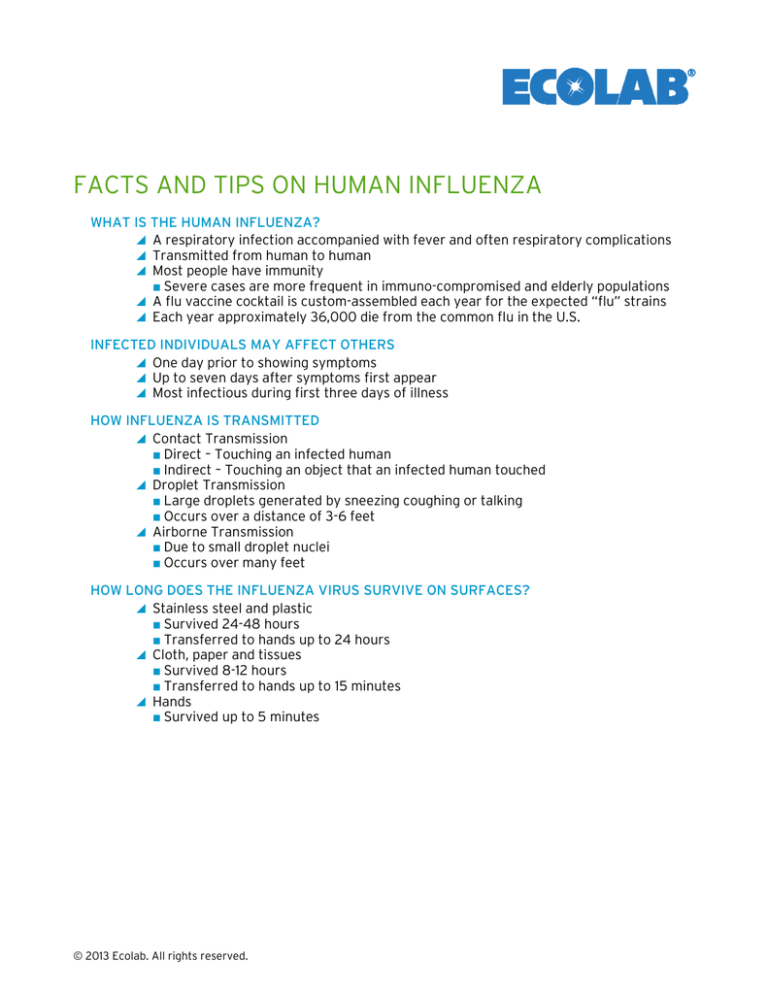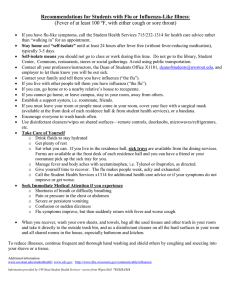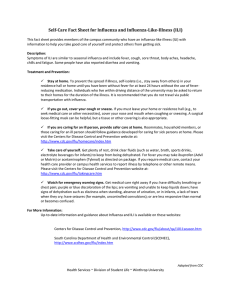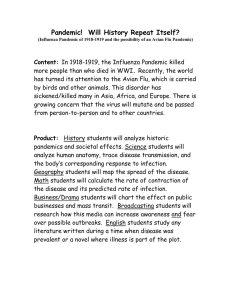
FACTS AND TIPS ON HUMAN INFLUENZA
WHAT IS THE HUMAN INFLUENZA?
A respiratory infection accompanied with fever and often respiratory complications
Transmitted from human to human
Most people have immunity
■ Severe cases are more frequent in immuno-compromised and elderly populations
A flu vaccine cocktail is custom-assembled each year for the expected “flu” strains
Each year approximately 36,000 die from the common flu in the U.S.
INFECTED INDIVIDUALS MAY AFFECT OTHERS
One day prior to showing symptoms
Up to seven days after symptoms first appear
Most infectious during first three days of illness
HOW INFLUENZA IS TRANSMITTED
Contact Transmission
■ Direct – Touching an infected human
■ Indirect – Touching an object that an infected human touched
Droplet Transmission
■ Large droplets generated by sneezing coughing or talking
■ Occurs over a distance of 3-6 feet
Airborne Transmission
■ Due to small droplet nuclei
■ Occurs over many feet
HOW LONG DOES THE INFLUENZA VIRUS SURVIVE ON SURFACES?
Stainless steel and plastic
■ Survived 24-48 hours
■ Transferred to hands up to 24 hours
Cloth, paper and tissues
■ Survived 8-12 hours
■ Transferred to hands up to 15 minutes
Hands
■ Survived up to 5 minutes
© 2013 Ecolab. All rights reserved.
FACTS AND TIPS ON HUMAN INFLUENZA
TOP TEN GENERAL INFLUENZA PREVENTION METHODS
MEDICAL
1. Receive a dose of the annual flu vaccination
2. Antiviral medications
■ Treatment as advised by your health care provider
NON-MEDICAL
Personal Hygiene
3. Cough Etiquette
■ Properly cover you mouth and nose with a tissue or sleeve when coughing or
sneezing – see CDC “Cover your Cough” at:
www.cdc.gov/flu/protect/covercough.htm start within 2 days of illness
4. Hand Washing
Proper Hand Washing Procedures
■ Wet hands with warm water
■ Apply soap to hands and rub hands together vigorously for 20 seconds, covering all
surfaces of hands and fingers
■ Rinse hands with warm water
■ Thoroughly dry hands with disposable towel or air blower
■ Use towel to turn off faucet
5. Hand Sanitizing (Alcohol rub/gel)
Proper Hand Sanitizing Procedures
■ Apply product to palm
■ Rub hands together covering all surfaces of hands and fingers
■ Rub until dry (15-20 seconds)
■ Use on visibly clean hands
■ Consider offering in public spaces
6. Avoid Touching Eyes, Nose and Mouth
■ Germs are often spread when a person touches something that is contaminated with
the virus and then touches his or her eyes, nose or mouth
HARD SURFACE CLEANING AND DISINFECTING
© 2013 Ecolab. All rights reserved.
FACTS AND TIPS ON HUMAN INFLUENZA
7. Clean
■ Organic material could protect the virus from sanitizers
■ Removal of the organic material is a key part of effective disinfection
8. Rinse
■ Detergents should be rinsed off to avoid dilution or inactivation of disinfectant
9. Disinfect
■ Follow directions for use on the product label of a properly EPA registered
disinfectant which has claims of effectiveness against influenza viruses (as listed on
the label)
■ Wipe down frequently touched surfaces with a properly registered disinfectant
- Light and air control switches
- Faucets and toilet flush levers
- TV and radio controls and telephones
- Door handles and push plates
- Other surfaces as needed
■ Disinfect all surfaces in the bathroom that may have contacted respiratory
secretions, urine or feces according to standard infection control procedures
(Carefully read and follow all product directions according to the EPA registered
product label)
10. Stay Home When You Are Sick
■ With cold or flu symptoms, stay home and get plenty of rest
■ Check with your local health care provider as needed
The information contained in this guide is in accordance with U.S. Centers for Disease
Control and Prevention (CDC) and World Health Organization (WHO)
recommendations. These recommendations are offered as a set of best practices to
help lower the probability of contracting influenza type viruses.
ADDITIONAL RESOURCES
CDC “Stopping the Spread of Germs at Home, Work & School”
www.cdc.gov/flu/protect/stopgerms.htm
US Department of Health & Human Services
“Pandemic Flu Planning Checklist for Individuals and Families”
www.pandemicflu.gov/individualfamily/checklist.html
US Department of Health & Human Services
“Business Pandemic Influenza Planning Checklist”
www.flu.gov/professional /business/businesschecklist.html
US Department of Health & Human Services
“Business Pandemic Influenza Planning Checklist”
www.flu.gov/planning-prepardnessl /business/businesschecklist.html
© 2013 Ecolab. All rights reserved.





